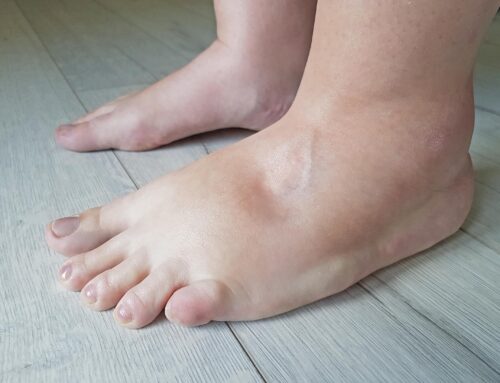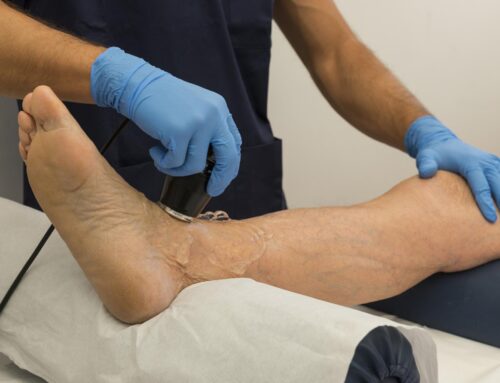Lymphedema, a condition characterized by the abnormal swelling of one or more limbs, arises due to the impaired flow of the lymphatic system. This can result from congenital factors, known as primary lymphedema, or as a consequence of surgery, radiation therapy, infection, or injury, termed secondary lymphedema.
The impact of lymphedema on individuals can be profound, affecting not only physical health but also emotional and psychological well-being. Symptoms can range from discomfort and heaviness in the affected limb to severe pain, decreased mobility, and recurrent infections, significantly altering one’s quality of life.
In the arsenal of management tools for this challenging condition, arm sleeves have emerged as a cornerstone for those experiencing upper limb lymphedema. These specially designed garments apply graduated compression to the arm, enhancing lymphatic fluid movement and reducing swelling. By mimicking the lymphatic system’s natural function, they help to manage symptoms, prevent progression, and improve the overall condition of the limb.
However, the effectiveness of an arm sleeve in lymphedema management heavily relies on selecting the right type of sleeve. Factors such as the level of compression, material, and fit must be carefully considered to ensure the arm sleeve not only offers the necessary support but also promotes skin health and wearer comfort.
What is Lymphedema?
Lymphedema is a chronic condition characterized by the accumulation of lymphatic fluid in the tissues, leading to swelling, most commonly in the arms or legs. This swelling occurs when the lymphatic system is either faulty from birth (primary lymphedema) or damaged by injury, surgery, radiation therapy, or infection (secondary lymphedema). The lymphatic system plays a crucial role in the body’s immune function and fluid balance, and when it doesn’t work correctly, lymph fluid builds up, causing swelling and other related symptoms.
Causes of Lymphedema
- Primary Lymphedema: This form is less common and is usually due to genetic factors that affect the development of the lymphatic vessels.
- Secondary Lymphedema: More prevalent, secondary lymphedema arises from external damage to the lymphatic system. Causes include cancer treatment (such as surgery to remove lymph nodes or radiation therapy), infection, trauma, or significant injury that affects the lymphatic vessels.
Symptoms of Lymphedema
- Swelling in part of the arm or leg, which may extend to the entire limb, including fingers or toes.
- A feeling of heaviness or tightness in the affected area.
- Restricted range of motion in the affected limb.
- Recurring infections in the affected limb.
- Hardening and thickening of the skin (fibrosis).
Compression Therapy for Lymphedema Management
Compression therapy is a cornerstone in managing lymphedema, aiming to reduce swelling, improve fluid movement, and prevent further buildup of lymphatic fluid. This therapy involves wearing compression garments such as arm sleeves, which apply gentle pressure to the affected limb, thereby promoting the flow of lymph fluid back into the circulatory system. The pressure these garments provide helps to:
- Maintain the reduction in limb swelling achieved through lymphatic drainage techniques.
- Improve the overall function of the limb by supporting the venous and lymphatic systems.
- Decrease the risk of infection by maintaining a more normal limb size and skin condition.
Compression arm sleeves are designed to be worn during the day, and in some cases, special compression garments are worn at night. The effectiveness of compression therapy largely depends on the proper selection and use of these garments, emphasizing the need for professional guidance in choosing the right compression level and fit.
Science Behind Arm Sleeves for Lymphedema
Compression arm sleeves are a fundamental component of lymphedema management, harnessing simple yet effective principles of physics to mitigate the symptoms of lymphedema. Understanding how these sleeves work requires a basic grasp of the body’s lymphatic system and its role in fluid balance.
How Compression Arm Sleeves Work
The lymphatic system is part of the body’s circulatory system, responsible for removing excess fluid, waste, and toxins from body tissues and returning them to the bloodstream. When this system is compromised, lymphatic fluid accumulates, leading to swelling known as lymphedema. Compression arm sleeves apply graded pressure to the arm, with the tightest pressure at the wrist and gradually decreasing up the arm. This design mimics the natural pressure gradient necessary for pushing lymph fluid back into the lymphatic vessels from the tissues.
The mechanism of action for compression sleeves involves:
- Enhancing Lymphatic Drainage: By exerting pressure on the surface of the limbs, compression sleeves encourage the movement of lymph fluid towards the trunk, where it can be more effectively processed by the body’s lymphatic and circulatory systems.
- Preventing Fluid Accumulation: The constant pressure prevents the backflow of lymph fluid, reducing the likelihood of fluid accumulation in the limb.
- Improving Venous Return: Compression also aids in improving venous return, assisting in the overall circulation and reducing the load on the lymphatic system.
Benefits of Using Arm Sleeves for Lymphedema
- Reduced Swelling: The primary benefit of wearing an arm sleeve is the reduction of swelling. Regular use of compression sleeves can significantly decrease the volume of the affected limb.
- Increased Mobility: By reducing swelling and providing support to the tissues, arm sleeves can enhance the range of motion and functional use of the affected limb.
- Decreased Pain and Discomfort: Many individuals report a decrease in sensations of heaviness, tightness, and overall discomfort with the use of compression sleeves.
- Prevention of Progression: Early and consistent use of arm sleeves can help prevent the progression of lymphedema, reducing the risk of complications such as infections and fibrosis.
- Improved Quality of Life: With the reduction in physical symptoms and the prevention of complications, individuals can experience an improved quality of life, engaging more fully in daily activities and experiencing less emotional and psychological stress associated with lymphedema.
Types of Arm Sleeves for Lymphedema
When navigating the options for lymphedema management, understanding the variety of arm sleeves available is crucial. These sleeves vary not only in terms of compression levels but also in the materials used, each offering unique benefits to suit individual needs and preferences.
Materials
- Synthetic Fabrics: Most arm sleeves are made from synthetic materials like nylon, spandex, or microfiber. These fabrics are chosen for their elasticity, durability, and ability to apply consistent pressure. They’re also quick-drying and breathable, making them suitable for daily wear.
- Cotton Blends: For those with sensitive skin, arm sleeves made from cotton blends offer a softer, more natural alternative. While they provide comfort, they may not offer the same level of durability or moisture-wicking properties as fully synthetic sleeves.
- Silver-Infused Fabrics: Some arm sleeves incorporate silver-infused fibers for their antimicrobial properties. These are especially beneficial for individuals prone to skin infections or those looking for extra hygiene support.
Compression Levels
- Light Compression (15-20 mmHg): Suitable for mild lymphedema or for those just beginning compression therapy. Light compression can also be beneficial for everyday wear to prevent the progression of lymphedema.
- Moderate Compression (20-30 mmHg): The most commonly recommended level for managing moderate lymphedema. It offers a balance between effectiveness and comfort, suitable for daily use.
- Firm Compression (30-40 mmHg): Recommended for severe lymphedema. This level provides significant pressure to effectively reduce swelling and manage the symptoms of advanced lymphedema.
Selecting the Right Type of Arm Sleeve
Choosing the appropriate arm sleeve involves more than just selecting the right material and compression level; it requires consideration of individual lifestyle, the severity of lymphedema, and personal comfort preferences.
- Consult a Healthcare Professional: Before making a choice, consult with a lymphedema therapist or healthcare provider who can assess your condition and recommend the most suitable compression level and sleeve type.
- Consider Your Daily Activities: Choose a sleeve that supports your level of activity. For active individuals, a durable, moisture-wicking sleeve might be best.
- Prioritize Fit and Comfort: A well-fitting sleeve is crucial for effective lymphedema management. Consider adjustable options or custom-fitted sleeves for the best fit.
- Factor in Skin Sensitivities: If you have sensitive skin, look for sleeves made from hypoallergenic materials or those designed for sensitive skin.
How to Choose the Right Arm Sleeve
Selecting the right arm sleeve for lymphedema management is a critical decision that can significantly affect your comfort and the effectiveness of the treatment. Several factors must be considered to ensure that the sleeve meets your specific needs. Here’s a comprehensive guide to help you make an informed choice.
Factors to Consider
- Size: Getting the correct size is paramount. An ill-fitting sleeve can either be too restrictive or too loose to provide any therapeutic benefit. Measure your arm at multiple points – the wrist, below the elbow, above the elbow, and near the armpit – to ensure a snug, comfortable fit that offers optimal compression.
- Compression Level: Arm sleeves come in various compression levels, typically ranging from light to firm compression. The severity of your lymphedema, as determined by a healthcare professional, will dictate the necessary compression level to effectively manage swelling and discomfort.
- Material: The choice of material affects the sleeve’s breathability, durability, and comfort. Consider whether you have sensitive skin, your level of daily activity, and the climate you live in. Materials can range from synthetic blends for durability and moisture control to natural fibers for softness and comfort.
- Style and Features: Some sleeves come with additional features, such as moisture-wicking properties, antimicrobial treatment, or UV protection. The style of the sleeve, including color and pattern, may also be important for your personal preference and lifestyle needs.
- Maintenance and Care: Consider how the sleeve needs to be cared for, including washing instructions and durability over time. A sleeve that is easier to maintain can make a significant difference in your daily routine.
Importance of Consulting with Healthcare Professionals
While the factors above provide a guideline, consulting with a healthcare professional, such as a lymphedema therapist or a doctor specialized in lymphatic disorders, is crucial for receiving tailored recommendations. They can:
- Assess Your Specific Condition: A professional can evaluate the severity of your lymphedema and recommend an arm sleeve that meets your specific needs, including the correct compression level and material.
- Provide a Custom Fitting: For optimal effectiveness, the sleeve must fit perfectly. Healthcare professionals can measure your arm accurately and, if necessary, recommend custom-made sleeves that match your exact dimensions.
- Offer Usage Guidance: Beyond selecting the right sleeve, a healthcare professional can advise on how often to wear it, any special care instructions, and when it’s time to replace it.
- Adjust Treatment as Needed: Your lymphedema management plan, including the use of arm sleeves, may need to be adjusted over time. Regular consultations ensure your treatment remains effective and responsive to any changes in your condition.
Choosing the right arm sleeve is a personalized process that can significantly impact the management of lymphedema. By considering the key factors and consulting with healthcare professionals, you can find a sleeve that not only helps manage symptoms but also fits into your lifestyle comfortably and effectively
L&R Tribute® Wrap Compression Sleeve
The L&R Tribute® Wrap Compression Sleeve stands out in the market for its innovative approach to lymphedema management. Featuring advanced foam technology, this sleeve is designed to adapt seamlessly to the wearer’s individual contours, ensuring personalized comfort and effective compression. The Tribute Wrap prioritizes skin health, with materials that are gentle on the skin while providing the necessary support to manage lymphedema symptoms. Its adjustable design allows for a custom fit, accommodating changes in limb size throughout the day or over time.
Measuring for the Perfect Fit
Achieving the perfect fit for an arm sleeve is essential for ensuring the effectiveness of lymphedema management and maximizing wearer comfort. An improperly fitted sleeve can lead to inadequate compression, discomfort, or even exacerbate lymphedema symptoms. Below is a step-by-step guide to accurately measure your arm for an arm sleeve, ensuring you get the most beneficial and comfortable fit.
Step-by-Step Measuring Guide
- Gather Your Materials: You will need a flexible measuring tape. If you don’t have one, a piece of string and a ruler can work in a pinch.
- Measure Your Wrist: Wrap the measuring tape around the smallest part of your wrist, just above the bone. This is your wrist measurement.
- Measure the Forearm: Find the fullest part of your forearm, close to the elbow. Wrap the measuring tape around this part to get your forearm measurement.
- Measure the Upper Arm: Measure the upper arm around its fullest part, which is typically halfway between your elbow and shoulder.
- Measure the Elbow (if required): Some sleeves require an elbow measurement. Bend your arm slightly and measure around the crease of your elbow.
- Length Measurement: For full arm sleeves, you’ll also need to measure the length of your arm. Start from the wrist measurement point and measure up to where you want the sleeve to end on your arm.
- Record Your Measurements: Write down each measurement as you go. These figures are crucial for selecting the correct size of the arm sleeve.
Importance of a Proper Fit
- Optimal Effectiveness: A sleeve that fits well will apply the correct amount of pressure needed to encourage lymph fluid drainage, helping to reduce swelling more effectively.
- Comfort: Comfort is key to compliance with any lymphedema treatment. A well-fitting sleeve is more comfortable to wear throughout the day, making it easier to adhere to your management plan.
- Prevent Slippage: Properly sized sleeves stay in place better, reducing the need for constant readjustments and the risk of constricting blood flow or causing discomfort.
- Skin Health: A sleeve that fits well helps maintain skin integrity by reducing the risk of irritation or pressure sores, especially important for those with sensitive or compromised skin.
Measuring your arm accurately is the first step towards finding an arm sleeve that can effectively manage lymphedema symptoms while ensuring comfort and compliance with your treatment plan. Always consult with a healthcare professional if you’re unsure about your measurements or the size of sleeve to order, and consider a custom-fitted sleeve for the best possible fit and effectiveness.
Caring for Your Arm Sleeve
Proper care of your arm sleeve is essential to maintain its quality, effectiveness, and longevity. An arm sleeve that is well-maintained can provide consistent compression, ensuring ongoing management of lymphedema symptoms. Here are some best practices for caring for your arm sleeve, along with guidance on how often it should be replaced.
Best Practices for Maintenance
- Daily Washing: It’s recommended to wash your arm sleeve every day after wearing it. Washing helps remove oils, sweat, and skin cells that can degrade the fabric and affect the sleeve’s elasticity. Use a gentle, skin-friendly detergent and lukewarm water.
- Hand Wash Recommended: While some sleeves can be machine washed in a lingerie bag on a gentle cycle, hand washing is generally safer and can help extend the life of your sleeve. Gently squeeze the fabric without wringing or twisting.
- Air Dry: Lay the sleeve flat or hang it to dry away from direct heat and sunlight. Avoid using a tumble dryer, as high heat can damage the elastic fibers.
- Avoid Bleach and Fabric Softeners: These can break down the fibers of the sleeve and reduce its compression ability. Stick to mild detergents formulated for delicate items.
- Rotate Sleeves: If possible, have more than one sleeve available to wear. Rotating sleeves not only allows proper cleaning and drying time but also helps ensure even wear and tear.
When to Replace Your Arm Sleeve
- General Guideline: As a general rule, an arm sleeve should be replaced every 3 to 6 months, depending on the frequency of use and the manufacturer’s recommendations. Over time, the sleeve will naturally stretch and lose its ability to provide adequate compression.
- Signs It’s Time for a New Sleeve: Look for signs of wear such as thinning material, fraying, loss of elasticity, or if the sleeve no longer feels as snug as when new. If you notice your symptoms worsening or that the sleeve doesn’t provide the same level of support, it’s likely time for a replacement.
- Consult with Professionals: Regular check-ins with your lymphedema therapist or healthcare provider can also help determine the right time to replace your sleeve, based on your specific condition and how the sleeve is fitting and functioning.
Proper care and timely replacement of your arm sleeve are key components of effective lymphedema management. By following these best practices, you can ensure that your sleeve continues to provide the support you need to manage your symptoms effectively, maintain your mobility, and enhance your quality of life.
Your Path Forward with Lymphedema
Compression Arm Sleeves are specialized garments are more than just accessories; they are essential tools that play a pivotal role in controlling swelling, enhancing lymph flow, and improving the overall quality of life for those living with lymphedema. By applying consistent and graduated pressure, arm sleeves help to maintain the progress achieved through therapy, prevent the worsening of symptoms, and support daily activities with greater comfort and mobility.
However, the effectiveness of an arm sleeve extends far beyond the fabric it’s made from. It represents a key component of a comprehensive management plan, tailored to meet the unique needs of each individual. This plan often includes manual lymphatic drainage, exercise, skin care, and dietary adjustments, all aimed at optimizing lymphatic function and minimizing the impact of lymphedema on your life.
The path to effective lymphedema management is a collaborative one, requiring the expertise and guidance of specialized healthcare providers. Whether you’re newly diagnosed, adjusting to changes in your condition, or seeking to optimize your management strategy, consulting with a lymphedema specialist or healthcare provider is a crucial step.
At Care-Med, our team of dedicated specialists is committed to providing personalized care and support for each of our clients. We understand the challenges of living with lymphedema and are here to help you navigate your treatment options, including the selection and fitting of the ideal arm sleeve to meet your needs.
We encourage you to take the next step in your lymphedema management journey. Book an appointment with us at Care-Med and discover the benefits of a customized approach to care. Together, we’ll explore the most effective strategies and tools, including the innovative L&R Tribute® Wrap Compression Sleeve, to manage your symptoms and enhance your well-being.
Share This Story, Choose Your Platform!
Table of Contents
We specialize in orthotics, body braces, and compression wear tailored to your unique needs in Toronto. Reach out to us at info@caremed.care or call 416-782-5353 to book your fitting and consultation.
Experience the difference of customized solutions designed just for you.











